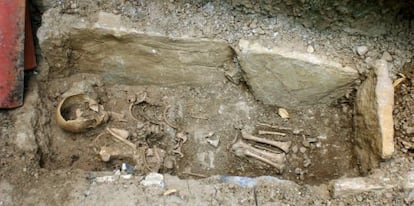Archeological discovery uncovered during building works at family home in León
Grave of child over 1,000 years old uncovered in garden during construction of a greenhouse

When Roberto Fernández Tejerina decided to build a greenhouse in the garden of his house in Cistierna in the region of Castilla y León, he hardly expected that he would uncover a thousand-year-old skeleton.
However, when the contractor he hired started to drill next to the crumbling wall remnants of an 11th-century pigeon loft, something sounded "different," said Fernández. Fragments of bone began to appear.
Fernández informed the Castilla y León regional government and an archeologist was sent to examine the remains. The thinness of the cranium unearthed and the dimensions of the grave - 1.15 meters long and half a meter wide - pointed to a child who lived in the Middle Ages, between 900 and 1000 AD. The skeleton was perfectly preserved as it had spent centuries covered by flat stone slabs. Unfortunately, the pneumatic drill damaged the skull when the find was discovered.
Although a regional government-commissioned report said the find was of great historical value, it recommended the bones remain where they are. "They told me I could do what I wanted, but that I should try to leave it untouched. To move it will require two people and I understand funds are needed for more important matters."
The regional government has not said whether it has sufficient money to excavate the find and is undecided on what to do with it. The architect who examined it initially and local historian Siro Sanz both recommended it be covered again for now to prevent damage.
I think we can coexist with this old resident... The boy should rest where his parents said goodbye"
Fernández has no problem with that solution: "It doesn't make me uneasy. I think we can coexist with this old resident," he says. "The boy should rest where his parents said goodbye."
According to Sanz, the child, 70 centimeters tall and between four and six years old, was a Christian, judging by the position he was buried in, with his feet pointing west and head to the east toward the rising sun, the same as a Muslim burial. But the investigators point out that Christians were traditionally buried face-up, while Muslims were placed on their side.
The find is of great value because it shows that there were human settlements in the region earlier than those already known, the reports stated. Cistierna is located in the eastern León sierra, to the rear of Cangas de Onís, the first capital of the Kingdom of Asturias.
"The tomb corresponds to a settlement where the Christians felt safe," says Sanz. At around 1000 AD, the Muslim Kingdom of Al-Andalus extended from the south up to the fringes of modern day León.
Until this find, it was believed that the 12th-century church of Santa María was the oldest vestige of settlement in Cistierna.
Fernández is still working on his greenhouse but after letting curious locals take a look he intends to place a slab over the remains to preserve them until the regional government makes a decision on their fate; a small act to mark the short existence of a Christian child a thousand years ago.
Tu suscripción se está usando en otro dispositivo
¿Quieres añadir otro usuario a tu suscripción?
Si continúas leyendo en este dispositivo, no se podrá leer en el otro.
FlechaTu suscripción se está usando en otro dispositivo y solo puedes acceder a EL PAÍS desde un dispositivo a la vez.
Si quieres compartir tu cuenta, cambia tu suscripción a la modalidad Premium, así podrás añadir otro usuario. Cada uno accederá con su propia cuenta de email, lo que os permitirá personalizar vuestra experiencia en EL PAÍS.
¿Tienes una suscripción de empresa? Accede aquí para contratar más cuentas.
En el caso de no saber quién está usando tu cuenta, te recomendamos cambiar tu contraseña aquí.
Si decides continuar compartiendo tu cuenta, este mensaje se mostrará en tu dispositivo y en el de la otra persona que está usando tu cuenta de forma indefinida, afectando a tu experiencia de lectura. Puedes consultar aquí los términos y condiciones de la suscripción digital.
Últimas noticias
From digital curfews to blocking apps: How technology experts protect their children online
Why the price of coffee has skyrocketed: from Brazilian plantations to specialty coffee houses
Confined to a Cuban hospital: When electricity is a matter of life or death
The complicated life of Francesca Albanese: A rising figure in Italy but barred from every bank by Trump’s sanctions
Most viewed
- Why we lost the habit of sleeping in two segments and how that changed our sense of time
- Trump’s obsession with putting his name on everything is unprecedented in the United States
- Pablo Escobar’s hippos: A serious environmental problem, 40 years on
- The Florida Keys tourist paradise is besieged by immigration agents: ‘We’ve never seen anything like this’
- Charles Dubouloz, mountaineering star, retires at 36 with a farewell tour inspired by Walter Bonatti









































